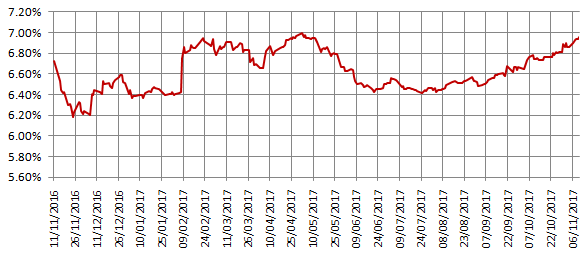Why long term debt mutual funds are underperforming short term funds

For the last 3 years bond markets in India had a terrific run. Debt mutual fund investors, especially those who invested in long term debt funds or income funds, enjoyed good returns from their investments, with top performing income funds giving nearly double digit annualized returns over the last 3 years. However, over the 3 or 4 months, we saw a reversal of fortunes for these funds and some income fund investors may understandably feel disappointed and worried.
In the last three months, long term income funds have given on average just 0.2% return, while short term debt mutual funds gave 1.08% average returns (please see our Mutual fund Category Monitor). What may be surprising to some mutual fund investors is that, money market mutual funds (liquid funds and ultra-short term debt funds) outperformed debt mutual funds (both short term and long term) in the last 3 months, something that does not happen frequently. One of our regular readers asked us, why are shorter term debt funds outperforming longer term funds?
In this blog post, we will discuss why long term debt funds are underperforming and probable near term outlook.
Readers who follow Advisorkhoj blog regularly know how debt mutual funds work, but for the sake of all readers, debt mutual funds invest in debt market and money market securities. Liquid funds and ultra-short term debt funds invest only in money market securities like commercial papers, certificates of deposit, treasury bills etc., while other debt mutual funds invest primarily in debt market securities like Government bonds (Gilts) and corporate bonds (non-convertible debentures).
There are two sources of income or returns for bond (both Government and Corporate bond) investors. The first source of income is coupon or interest paid by the bond. The second source of income is the price appreciation of the bond in the market. If the price of the bond increases, then your return will be higher, but if the price of the bond falls, then your return will be lower. The price of a bond depends on two factors:-
- Interest rate expectations
- Credit risk expectations
If interest rate goes up or investors feel that interest rate will go up in the future, then the price of the bond will fall. If bond prices fall, debt fund returns will be lower. If interest rate falls or investors feel that interest rate will fall in the future, then the price of the bond will rise. If bond prices increase, then debt fund returns will be higher. Similarly, if credit risk of a bond improves, then bond prices will increase and if credit risk deteriorates, then bond prices will fall. Credit risk is bond specific (Government bonds do not have any credit risk), but interest rate expectations will affect all bonds in the market. Therefore, in this post, we will limit our discussion to interest rate risk.
Different bonds have different sensitivities to interest rate changes; bonds with longer maturities are more sensitive to interest rate changes while shorter maturity bonds are less sensitive. The interest rate sensitivity of a bond is measured by a metric known asModified Duration. Modified duration is the percentage change in the bond price for 1% change in the interest rates.
It is important for investors to understand what we mean by interest rate in the context of bond prices. Many investors take the repo rateas the relevant interest rate for bonds / debt funds. We get questions from investors asking, why did a debt fund NAV fall even though Reserve Bank of India (RBI) kept repo rate unchanged? You should understand that, while the RBI repo rate is the most important interest rate in the economy, it is not the most relevant interest rate for bonds prices. Bonds are traded in the market and like all traded items the price depends on demand and supply of the item.
Let us understand the bond demand / supply and interest rate relationship with the help of a hypothetical example. Let us suppose, you invested in a 5 year bond which is paying you 8% annual interest two years back. Now you see or expect to find 3 year bonds (3 years is the residual maturity of your bond) which will pay you 9% interest. You will not want to hold on to your bond for two more years, when you can sell the bond and re-invest in a bond which pays you higher interest over your interest rate period. You are not the only investor who will be thinking of selling the 8% bond; everyone who invested in the 8% bonds will be thinking on similar lines. In order to sell, you need to find a buyer, but the buyer will not be interested in buying your bond, unless you lower the price. Therefore, when investors expect interest rates of relevant bond maturities to go up, the price of the bond falls. Exactly the opposite effect comes into play, when future interest rate expectations are on the lower side; bond prices increase.
There is always demand for credit in the economy, whether by the Government or in the private sector. The bond or debt fund investor, whether domestic (like us) or foreign (FII) is the lender; lenders always want to get the highest returns (interest rate) while the borrowers want lower borrowing costs (interest rate). The Government of India is the biggest borrower in our economy;the revenues of the Government are lesser than its expenses. It meets the gap through borrowing from investors; this gap, in crude terms, is known as the fiscal deficit. Higher the fiscal deficit more is the borrowing need of the Government. If the Government wants to borrow more money from domestic and international lenders then it has to pay a higher interest rate. The relationship between fiscal deficit and interest rate expectation is very important. If fiscal deficit is seen to be widening, investors will sell bonds and this will cause bond prices to fall; as a result debt mutual fund returns, especially that of long term funds, will also fall.
International factors also affect interest rates. If interest rates in developed countries like the United States rise, risk return trade-offs will favour developed market bonds relative to emerging markets like India. In such a scenario, foreign investors will sell bonds in emerging markets and invest in developed markets. Bond sell off by foreign investors will not just affect bond prices; it will also affect the exchange rate because the demand for developed currencies like the dollar will increase. Depreciating currency will force emerging markets to offer higher yields to attract foreign investments. This will put more pressure on bond prices and in turn on debt mutual fund returns.
We devoted a lot of space in this blog post to explain the basic economic concepts related to bond prices because our primary objective in Advisorkhoj.com is investor education; we want investors to better understand how macro-economic situations affect their investments. We will now discuss some economic and political developments in the last 3 to 4 months, both globally and in India, which affected bond and debt mutual fund returns.
What happened in the last 3 months?
The chart below shows the 10 year Government bond yields over the last 12 months (remember yields and prices / returns are inversely related).

Source: Investing.com
You can see that the yield spiked up in February but came down, but from August onwards the yield has been increasing steadily and now it is close to 7%. This has caused bond prices to fall and long term debt funds to give lower returns. Why did this happen?
Over the last few months we saw bond sell off, in most emerging markets, including India, on the back of appreciating US Dollar due to strong economic growth in the US. Treasury bond (US Government bonds) yields are higher on account of higher inflation expectations on back of strong GDP growth fuelling expectations of interest rate (fed funds rate) hikes by the Federal Reserve.
Retail investors should understand that global investors consider US Treasury bonds as the safest asset in the world and naturally when their yields rises, US Treasury bonds become an attractive asset at the expense of emerging market bonds, like Indian Government and corporate bonds. Dollar appreciation versus the rupee and higher Treasury bond yields saw foreign investors selling Indian bonds, causing a decline in bond prices and higher bond yields in India (yields are inversely related to bond prices). This was the biggest reason for lower debt fund returns over the past 3 months or so.
Local factors related to demonetization and Goods &Services Tax (GST) roll-out increased concerns whether our fiscal deficit will increase. Demonetization had an effect on GDP growth. GDP growth in Q4 of FY 2017 slowed down to 6.1% primarily due to demonetization. GDP growth in Q1 of FY 2018 slowed down further to just 5.7% due to the twin impact of channel destocking caused by GST roll-out and the lingering effects of demonetization. The RBI has kept the repo rates unchanged due to inflationary concerns. Fears of widening fiscal deficit have put upward pressure on bond yields, affecting debt fund returns.
Outlook
The US economic data is strong and since economic growth is inflationary, there are fears of imminent Fed Funds rate hike. Increase in the fed rate will put pressure on bond prices in India. Though the Fed kept rates unchanged in September, it hinted at a rate hike in December. This will keep the bond markets jittery in India and other emerging markets. Investors are also concerned about potential developments when the Federal Reserve Governor, Janet Yellen’s term ends in a few months (January 2018).
The US President, Donald Trump, was critical of Fed Governor throughout his Presidential election campaign and there are rumours in the market that, Yellen’s term may not be extended by the US Senate where the Republicans have a majority. The current Governor was seen as a policy dove, favouring an accommodative (relatively lower interest rates) monetary policy. Rumours are that, she might be replaced by someone who may have hawkish stand as far as monetary policy is concerned. These concerns may keep bond markets under pressure for the next few months, at the very least.
Let us now discuss domestic factors affecting bond markets in India. Demonetization and GST are major structural reforms in our economy; major structural reforms usually have a disruptive effect on economic activity. Economists, globally and here in India, believe that the GDP slowdown due to demonetization and GST to be only short term in nature. The length of “short term” in terms of months, quarters etc. is, however, the big question. This reforms are massive, in terms of impact on the economy, and there is not much historical precedence here or anywhere else in the world, to estimate the short impact of these reforms on the GDP. So, fiscal deficit concerns are not going away anytime soon. There are also concerns with regards to inflation with vegetable prices increasing. However, the major concern with regards to inflation is to do with crude oil prices.
India imports 80% of its crude oil demand. International crude price, therefore, has a huge impact on our inflation, fiscal deficit and our exchange rate. If the Government passes the crude price increase to customers, it will be inflationary and this will reduce the room for RBI to cut interest rates; in fact, it may even prompt concerns of a rate increase in India. This will have a negative effect on the bond market. If the Government subsidizes consumers and absorbs the crude price increase, then it will put pressure on the fiscal deficit, at a time when it is already under pressure due the economic slowdown (that we discussed earlier). Again, this will have a negative impact on the bond market.
Since we have to import most of the crude oil for domestic consumption, crude price increase will increase the demand for dollars and cause the rupee to depreciate. Rupee depreciation will make Indian bonds unattractive for foreign investors. Many economists are linking the rise in crude prices to the political developments in Saudi Arabia, which is the largest exporter of crude oil in the world. Major political changes are underway in Saudi Arabia, especially within the royal family. King Salman, aged 81, changed the decades old seniority based succession custom within the royal family by naming his own son, Prince Mohammed as his successor.
This is seen as a very unorthodox move in Saudi Arabia because Prince Mohammed is much younger than the other rivals to the throne and is causing political tensions in the kingdom. The young price is said to have the backing of the United Sates and is driving major economic changes in his country. The IPO of Saudi Aramco, the stated owned oil producer, is being driven by Prince Mohammed and can have major repercussions for the crude oil market. Long story short, their uncertainty about the trajectory crude prices and as discussed earlier, this will have an impact on our own economy and the bond market.
What should debt fund investors do?
This blog post turned out to be longer that I had intended to when I started writing this post. I was tempted to cut short this fairly long article, but I felt it is important for investors to understand how bond prices and debt fund returns are affected by macro developments(both globally and in India) because many investors do not understand how fixed income investing works. We also discussed in fair amount of detail the various factors which affected debt mutual fund returns in the last few months because it is important to know, why their investments behaved in the way they did. Finally, we also discussed the near term bond market outlook, so that investors have a clear perspective before they invest. As far as outlook is concerned, readers should appreciate the fact that outlook is based on what we know so far; if we have new information, which is very different from what we have now, the outlook may change.
We, in Advisorkhoj, always advocate that your investment decisions should be determined by your financial objectives and not market conditions. If you want to invest in long term debt mutual funds expecting a rate cut and high returns in the short term, you may be disappointed due to the factors discussed in details in this post.
If your investment horizon is short term, 2 to 3 years or less, you should invest in short term debt mutual funds now. Short term debt mutual funds are less affected by interest rate expectations. Short term debt mutual funds may show some volatility, but if you match your investment tenure with the modified duration of the fund (you will find modified duration of a scheme in the factsheet), then your returns will not be impacted by price volatility.
If your investment horizon is 1 year or less, ultra-short term debt mutual funds may be a better choice.You should invest in long term debt mutual funds only if you are willing to remain invested for 3 years or more and not be perturbed by volatility. Debt mutual funds are wonderful short term investment options and can give better investment returns than traditional fixed income options (FDs, Post Office small savings schemes); you simply need to knowthe right type of debt mutual funds to invest.
Mutual Fund Investments are subject to market risk, read all scheme related documents carefully.
RECOMMENDED READS
LATEST ARTICLES
- Why you need to have hybrid mutual funds in your portfolio: Different types of funds Part 2
- Why you need to have hybrid mutual funds in your portfolio: Misconceptions Part 1
- Which is the best time to invest in mutual funds
- Economic slowdown: Is it real and what should you do
- Importance of liquidity in investing: Mutual funds are ideal solutions
An Investor Education Initiative by ICICI Prudential Mutual Fund to help you make informed investment decisions.
Quick Links
Follow ICICI Pru MF
More About ICICI Pru MF
POST A QUERY




